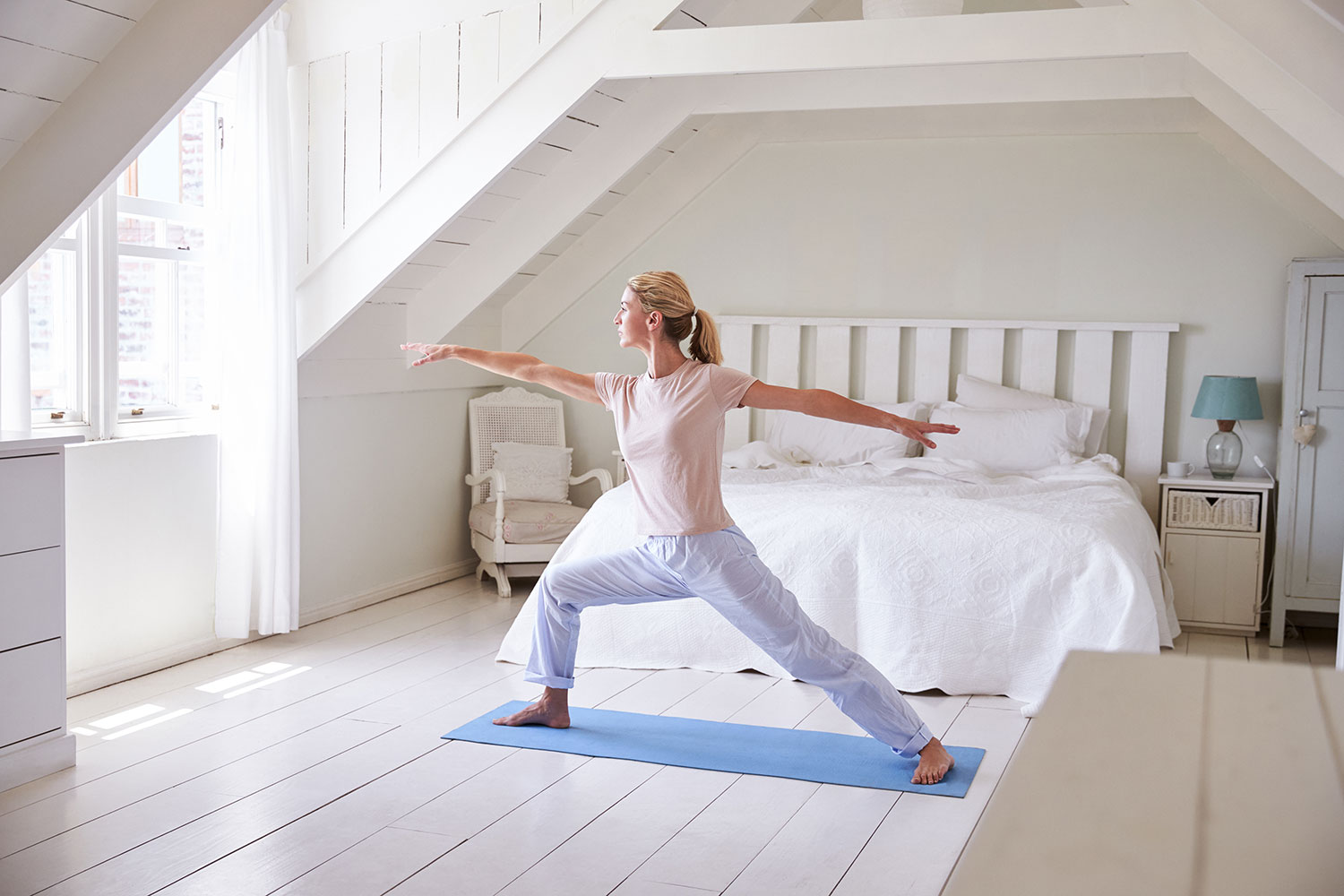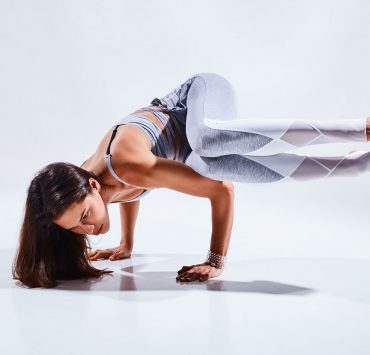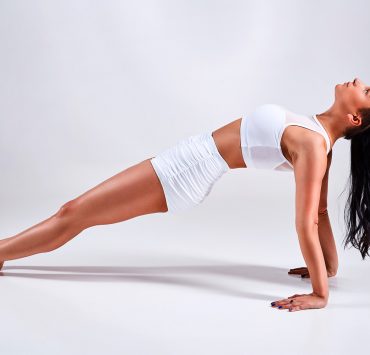
Yoga, meditation, and spirituality are at the top of the…
When life gets crazy amongst the endless list of to-dos, sometimes we need to take a quiet moment to let go of stress, reconnect to ourselves, and turn inward—and yoga can give us the opportunity to do exactly that. This gentle, restorative practice will help you focus in, take care of your physical body, and reconnect to your mind.
The Sequence

Child’s Pose
Start in Child’s Pose to bring your focus to the present and connect with your breath. Stay here for at least 10 breaths.
Thread the Needle Pose
Push up to all fours, and then move into Thread the Needle with your left arm. Hold for at least 5 breaths, and then repeat on the right side.
Downward Dog Pose
Push back into Downward Dog, bending your knees to stretch out your legs. Stay here for 5 breaths.
Forward Fold with Clasped Elbows Pose
Step up into Forward Fold, and grab hold of your elbows. Bend your knees as much as you need as you allow your back to release. Hold for 5 breaths, switching your grip halfway through.
Halfway Lift, Forward Fold, Upward Salute Pose (Repeat 3 times)
Release your hands to the ground. Move up into Halfway Lift, bend back down, and then slowly stretch up into Upward Salute. Bend back down through heart center, and repeat two more times.
Downward Dog Pose
From Forward Fold, step back into Downward Dog. Hold for 5 breaths.
Seated Forward Fold Pose
Come down to the ground and move into Seated Forward Fold. Place a bolster on your thighs to rest on for an even more restorative approach. Hold for at least 5 breaths.
Supported Bridge Pose
Lie back on the ground and move into Supported Bridge Pose, with a block underneath your sacrum. Hold for at least 5 breaths.
Bound Angle Pose
Release from Bridge Pose, and bring your feet together for Bound Angle Pose. Place blocks underneath your knees for support if necessary, or lay down on a bolster or blanket. Hold for at least 5 breaths.
Savasana
Move any props out of the way and shift into Savasana. Hold for at least 20 breaths.
Breakdown of Key Postures
If you need a breakdown of any of the poses, this will help you familiarize yourself with each posture in the sequence.
Balasana — Child’s Pose

Child’s Pose, or Balasana, is a restorative pose that helps you relax, calm the mind, and center your focus. Physically, it stretches the back, thighs, and ankles.
Instructions:
Start on your knees, sitting back onto your heels. Separate your knees from each other so that there is space to fit your torso between your legs, but ensure your big toes remain touching.
On an exhale, bend forward from your hips and bring your torso forward, leading your forehead to the ground. Your torso should rest between your knees.
Extend your arms out in front of you, with your palms resting on the ground and arms remaining active and lifted. Ensure that you are releasing your tailbone towards your heels, and continue to lengthen your spine as you deeply breathe in this position. Slowly lead yourself back up to your knees to release.
Parsva Balasana — Thread the Needle Pose

Thread the Needle, or Parsva Balasana, gently twists the spine and torso to stretch the upper back and shoulders.
Instructions:
Start in a table top position, with your palms and knees on the ground. Your wrists should be aligned directly under your shoulders, and your knees under your hips. Bring your head in a neutral position, with your gaze downwards.
On an exhale, lift the weight off your right hand and slide your right arm underneath your left arm, with your palm facing up. Your right shoulder should rest down on your mat, along with your right ear, with your gaze now facing left.
Your left arm can be bent or extended out in front of you, and your hips should remain raised. Bring awareness to your shoulders, neck, and lower back, and let go of any tension as you breathe through this pose. To release, bring your left hand back in line with your head if you extended it. Slowly push through your palm, return to table top, and repeat on the other side.
Adho Mukha Svanasana — Downward Facing Dog Pose

Downward Facing Dog, or Adho Mukha Svanasana, allows you to wake up the body while getting a deep stretch in your calves and hamstrings.
Instructions:
Start from a tabletop position, with your hands below your shoulders and knees below your hips. On an exhale, engage your core, curl your toes, and lift your knees off the ground, working towards straight legs. Stretch your tailbone back and up towards the ceiling.
Your head should remain active, with your gaze focused in between your legs. Continue to push through your index fingers and thumbs.
Before settling into stillness, allow yourself to focus the stretch on the back of your legs by bending one knee and then the other. You may also choose to bend both knees at the same time, and then push back through your heels towards straight legs.
Urdhva Hastasana — Upward Salute Pose

Upward Salute, or Urdhva Hastasana, is an energizing pose that stretches the entire body.
Instructions:
Start standing, with your feet parallel to each other, either together or hips-width distance apart. Roll your shoulders back and elongate through your spine.
On an inhale, sweep your arms up by your sides and over your head. Your arms should be shoulder-width distance apart, with your palms facing in towards each other.
Feel your feet on the mat, and ground down through all four corners of your feet. Ensure you continue to elongate through your spine, and keep your shoulders away from your ears. Your gaze should remain straight in front of you. To release, slowly bring your arms back down to your sides.
Paschimottanasana — Seated Forward Fold Pose

Seated Forward Fold, or Paschimottanasana, is a simple posture that provides a stretch to the back of the legs.
Instructions:
Begin seated (on a block or blanket if you’d like) with your legs out straight in front of you.
Be sure that your spine is elongated and gaze forward. On an inhale, raise your arms above your head. On an exhale, bend at the hips and begin to reach your arms and torso forward.
You can place your hands wherever is accessible, and bend your knees if you’d like. You can place a bolster on your thighs and rest your torso on it for a more restorative option. As you inhale, elongate through your spine, and as you exhale, gently drive your chest closer to your toes.
Setu Bandhasana — Supported Bridge Pose

Bridge Pose, or Setu Bandhasana, helps to open up the chest and shoulders while strengthening the legs. By placing a block underneath the sacrum, the pose becomes more restorative.
Instructions:
To get into Bridge Pose, begin on your back with you knees bent and feet flat on the ground. Begin to lift the hips up to create a diagonal line from the head to the knees, while keeping your glutes soft but core engaged.
Keep your neck relaxed and roll your shoulders away from your ears. Take a block and place it underneath your sacrum. The most common setting is on the medium height, but you can place it on the highest setting if you are open enough in the back.
To release from the pose, remove the block and slowly roll down from your shoulders to your glutes.
Baddha Konasana — Bound Angle Pose

Bound Angle Pose, or Baddha Konasana, helps you stretch into the often-neglected inner thighs. The pose is also excellent for opening up your hips and stretching your groin muscles.
Instructions:
Start seated, with your legs out in front of you. On an exhale, bend your knees and bring your feet towards you. Place the soles of your feet together in front of your pelvis, letting the outside edges rest on the mat.
Allow your knees to drop to either side at a comfortable level. Do not force them down so that they are touching the ground–let them hang in space if that is what is accessible. Grab hold of your feet, and bring them as close to your pelvis as comfortable, while still keeping them on the ground.
Breathe through this posture, ensuring that your spine remains elongated and shoulders relaxed. Hold for about a minute, and then release back to a comfortable seated position.
Savasana — Corpse Pose

Corpse Pose, or Savasana, is the perfect end to a restorative yoga sequence. It allows you to relax deeply, fully release tension, and absorb the benefits of your practice.
Instructions:
Lie down on your back. Let your feet fall outward, and place your hands about 6 inches away from your body, with your palms facing up.
Before fully getting into Savasana, get completely comfortable by getting any fidgets out and adjusting your position. Once you have found stillness, close your eyes and pay attention to your breath.
You can do a body scan by focusing on a body part and releasing tension in that area. Allow your eyes to rest deeply in their sockets, and let your breath be deep and slow.
To release from the pose, roll over to one side into fetal position, and then slowly guide yourself back up to a seated position.
If your in need of a quiet moment to reconnect with yourself, give this sequence a shot. Use it anytime you need to slow down, calm the mind, and find your center.
What's Your Reaction?
Yoga, meditation, and spirituality are at the top of the list for writer and former nutritionist Amanda Carter. This devoted practitioner enjoys writing about health and wellness just as much as she enjoys living it.














